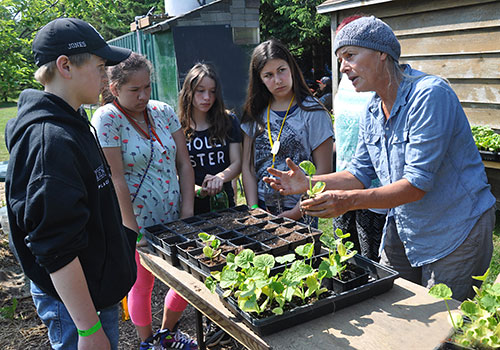
Tiny seedlings have begun to sprout at the Guelph Centre for Urban Organic Farming (GCUOF) with the help of many green thumbs. Two of those thumbs belong to Martha Scroggins, GCUOF co-ordinator and sessional lecturer in plant agriculture.
On May 28, she led a group of aboriginal students in Grades 7 and 8 on a tour through the 2.5-acre farm. The students were taking part in a three-day program at U of G called Establishing an Aboriginal Gateway in Learning and Education (EAGLE). They stayed in residence, toured the campus and met with aboriginal elders.
Scroggins showed the students around the farm and gave them tips on how to grow their own fruits and vegetables (they received seedlings to take home).
Amber Thomas, a student from J.C. Hill Elementary School in Ohsweken, Ont., took home a tobacco plant for her mother’s garden. Tobacco is considered a traditional medicinal plant in aboriginal culture, along with sage and sweet grass, which also grow at the GCUOF.
What did Thomas learn from the garden tour? “You can use manure to help plants more,” she says. “You can use tires to grow plants.” Tires make ideal raised beds for plants, says Scroggins, especially in rocky areas. They can be stacked for extra depth and filled with soil, compost and manure.
The visit gave students the opportunity to see their learning in practice. “We talk a lot about food sustainability, how we need to know where our food is coming from and how it gets to our table,” says Erin Greig-Tally, a teacher at Kikendaasogamig Elementary School in Neyaashiinigmiing, Ont. “They’re learning how to feed themselves in a traditional way.”
The students also learned about the traditional “three sisters” method of growing corn, beans and squash. Planting these crops together results in a symbiotic relationship: the corn supports the beanstalks, while the squash spreads over the ground, keeping it cool and moist.
When the GCUOF was established in 2008, its aim was to grow crops with no supplemental water. Without sprinklers or an irrigation system, Scroggins brought water from home. “Everything we planted in the ground relied on the weather,” she says.
The centre now has a solar-powered water pump that extracts water from 150 feet underground. But this spring’s lack of rain has made planting more challenging. The water level in a small pond at the centre is the lowest it’s been in five years.
As a certified organic farm, Scoggins adds, none of the crops are grown using any “cides”— insecticides, herbicides or fungicides.
Scroggins says some of the plant species growing at the centre are thousands of years old. Generations of farmers collected the seeds that are now today’s crops. The practice yields stronger, healthier plants because they grow in the same area for so long that they adapt to the soil and its microbes.
The centre grows between 150 and 200 types of plants. Some of the plants are being grown in greenhouses for U of G research projects. “Organic research brings in some much needed funding to keep the garden going,” says Scroggins.
Some of the fruits and vegetables grown at the centre are destined for Cutten Fields, P.J.’s Restaurant or even your own dinner table. The centre also sells plants and produce on campus.
Growing your own food isn’t easy; even Scroggins has experienced crop failures. “A lot of times I’ve had to plow down crops,” she says. “If you want food, you have to work.”